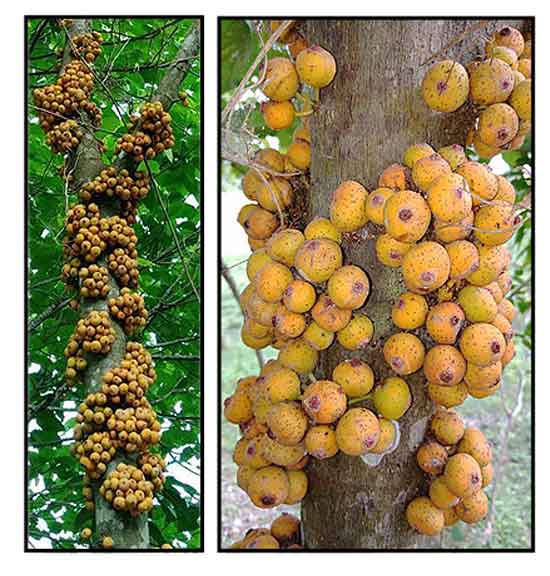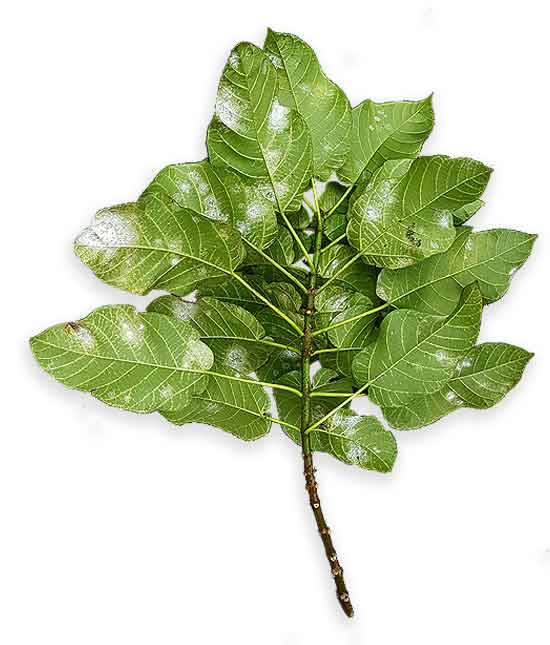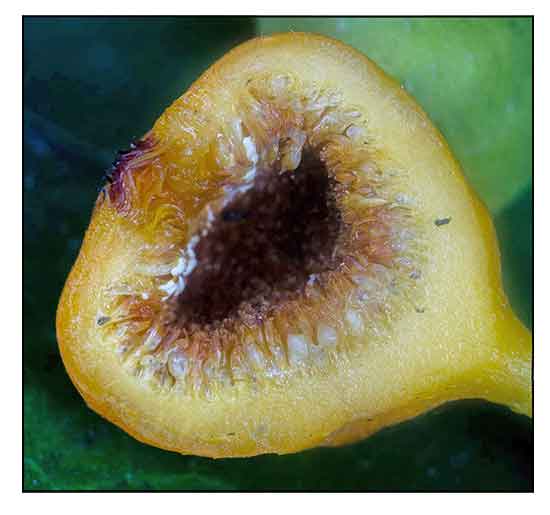 Gen info Gen info
- Ficus is a genus of about 850 species of woody trees, shrubs, vines, epiphytes, and hemiepiphytes, the largest genus in the family Moraceae. They are collectively known as figs or fig trees. Species are relatively easy to recognize—many have aerial roots and a distinctive shape or habit. The fruit is an inflorescence enclosed in an urn-like structure called a synconium; in essence, the fig fruit is a fleshy stem with multiple flowers that fruit and coalesce. (2)
Botany
• A tree, the young parts scabrid-hispid. Leaves opposite; those of the same pair unequal in size and unequally petiolate, from broadly ovate to elliptic; the apex acute or sub-acute; the edges rather coarsely and irregularly crenate-serrate; the base deeply cordate, slightly unequal, 5-nerved; primary lateral nerves about 6 pairs; both surfaces scabrous-hispid; length of blade 5 to 10 in.; petioles 75 to 4 in. long, scabrid; stipules lanceolate, hispid' 5 in. long. Receptacles in fascicles from short rough tubercles on the stem and larger branches, pedunculate, globose, pyriform, umbonate, slightly verrucose, shortly hispid, pale yellow when ripe, about -6 in. across; umbilical scales prominent; basal bracts none or irregular; peduncles thin, hispid, with 1 or 2 bracteoles, nearly 1 in. long. Fertile female flowers with a gamophyllous, deeply 5-cleft perianth; carpel elongate-ovate; style thin, lateral. Male and gall flowers not seen. (8)
 • Tree up to 20 m tall. Leafy twigs 3-8 mm thick, whitish hispidulous to (sub)glabrous, ± scabrous; internodes mostly hollow. Leaves (sub)opposite or spirally arranged, pairs on horizontal twigs usually unequal; lamina elliptic to oblong to (sub)ovate to subcordiform, 10-32 by 7-20 cm, symmetric or ± asymmetric, chartaceous, apex acumiinate, base cordate to rounded, margin crenate-dentate to subentire; upper surface hispidulous, scabrous, lower surface sparsely to densely whitish (sub)-hispidulous on the veins, scabrous; cystoliths on both sides; lateral veins 5-10 pairs, the basal pair up to 1/3-1/2 the length of the lamina; petiole 2-9 cm long, varying in length on the same twig, whitish hispidulous to densely puberulous, the epidermis persistent; stipules semi-amplexicaul, 0.5-1 cm long, sparsely minutely strigillose, caducous. Figs axillary, in pairs or solitary, mostly ramiflorous to cauliflorous, on clusters of leafless branchlets with short internodes, down to the trunk; peduncle 1-5 cm long; peduncular bracts 1-3, scattered, c. 1 mm long; receptacle (sub)globose, 0.8-1.5 cm diam. when dry, hispidulous and scabrous or glabrous and smooth, with few 0.5-1 mm long lateral bracts, yellow to blood-red at maturity, apex ± convex to almost flat, ostiole c. 3 mm diam., surrounded by a low rim; internal hairs few to abundant, whitish to brownish. Tepals whitish to reddish, sparsely hairy at the apices. Styles glabrous. (Flora Malesiana) (6) • Tree up to 20 m tall. Leafy twigs 3-8 mm thick, whitish hispidulous to (sub)glabrous, ± scabrous; internodes mostly hollow. Leaves (sub)opposite or spirally arranged, pairs on horizontal twigs usually unequal; lamina elliptic to oblong to (sub)ovate to subcordiform, 10-32 by 7-20 cm, symmetric or ± asymmetric, chartaceous, apex acumiinate, base cordate to rounded, margin crenate-dentate to subentire; upper surface hispidulous, scabrous, lower surface sparsely to densely whitish (sub)-hispidulous on the veins, scabrous; cystoliths on both sides; lateral veins 5-10 pairs, the basal pair up to 1/3-1/2 the length of the lamina; petiole 2-9 cm long, varying in length on the same twig, whitish hispidulous to densely puberulous, the epidermis persistent; stipules semi-amplexicaul, 0.5-1 cm long, sparsely minutely strigillose, caducous. Figs axillary, in pairs or solitary, mostly ramiflorous to cauliflorous, on clusters of leafless branchlets with short internodes, down to the trunk; peduncle 1-5 cm long; peduncular bracts 1-3, scattered, c. 1 mm long; receptacle (sub)globose, 0.8-1.5 cm diam. when dry, hispidulous and scabrous or glabrous and smooth, with few 0.5-1 mm long lateral bracts, yellow to blood-red at maturity, apex ± convex to almost flat, ostiole c. 3 mm diam., surrounded by a low rim; internal hairs few to abundant, whitish to brownish. Tepals whitish to reddish, sparsely hairy at the apices. Styles glabrous. (Flora Malesiana) (6)
• Ficus heteropoda have tiny bracts on the surface of the fig, which distinguishes Ficus heteropoda from Ficus variegata, which looks superficially familiar. (6)
 Distribution Distribution
- Native to the Philippines.
- Throughout the Philippines; in low elevation forests and secondary growth.
-
In Coron, Danjugan, Guimaras, Leyte; Luzon: Camarines Norte, Camarines Sur, Isabela, Quezon, Rizal, Sorsogon; Mindanao: Agusan del Norte, Bukidnon, Surigao, Zamboanga, Zamboanga Sibugay; Mindoro, Negros, Palawan, Panay, Polillo, Samar, Sibuyan. (7)
- Also native to Maluku and Sulawesi. (1)
Constituents
- Phytochemical study of methanol leaf extract yielded flavonoid, triterpenoid, and steroid compounds. (see study below) (5)
Properties
- Study suggests antibacterial property.
Parts used
- Leaves, bark.
Uses
Edibility
- A few blogs warn that the fruit is poisonous; many describe the fruits as edible, sweet and juicy.
- Note: No studies found on toxicity.
Folkloric
- In Subanen tribe of Lapuyan, Zamboanga del sur, use infusion of trunk scrapings for treatment of tuberculosis. Infusion of small slices of trunk drunk as antibiotic after bleeding. (4)
Studies
• Antibacterial / Leaves: Study evaluated the chemical content and antimicrobial activity of methanol leaves extracts of five Ficus species viz., Ficus ampelas, F. ardisioides, F. fistulosa, F. heteropoda, and F. hirta against Staphylococcus aureus, Bacillus subtilis, Pseudomonas aeruginosa, Escherichia coli, Candida albicans, and Aspergillus niger using agar disc diffusion. Ficus heteropoda and F. ardisioides inhibited the growth of S. aureus and B. subtilis with variable inhibition. (see constituents above) (5)
Availability
Wild-crafted. |

![]()






